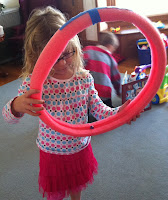

I came across a new desk recently while on Twitter, Facebook or maybe Google. Regardless, in my opinion this product looks really amazing to use in the schools. In my experience, it can be difficult to have the proper seating in every classroom for an individual with a disability especially as students get older and change classes. Although I have not tried it personally, the Desktop Desk seems very promising. Wouldn't is also be nice to have one in the OT room for ease of use when working on an angled surface? I asked the creator of the desk, Rob Mayben, a special education teacher, to answer a few questions. To get an idea of how the Desktop Desk works be sure to check out the links to the videos or start with this
video, because the visual of the desk in use is very helpful. His answers are so interesting about the creation of the desktop desk and how innovative products are created based on need.
 Once again thank you for the opportunity to talk about the desktop desk. The following are answers to your desktop desk questions. I am real passionate about providing access and opportunities and what the desktop desk is providing. I am a Teacher first, but sure am having a lot of fun with my desktop desk adventure - Rob Mayben.
Once again thank you for the opportunity to talk about the desktop desk. The following are answers to your desktop desk questions. I am real passionate about providing access and opportunities and what the desktop desk is providing. I am a Teacher first, but sure am having a lot of fun with my desktop desk adventure - Rob Mayben.
Thank you Rob!
Question #1: Why did you design the product?
The first desktop desk was developed for Neil. Neil has Cerebral Palsy and because of his large wheel chair and poor motor skills struggled to actively participate in my Special Education Math/Woodshop class. I did not have a plan to develop, manufactured, and market a product, I simply wanted to put something together to help Neil independently access and participate in class activities. I think many Special Education Teachers actively work to find ways to help their kids participate as independently as possible through self made devices, and that is how the desktop desk started. The first desktop desk prototype provided access and immediately allowed Neil to independently participate in academics along side his peers. The moment I saw Neil writing INDEPENDENTLY on the desktop desk prototype, with no help from me or his adult aide was to this day was my best teaching moment.
A couple of days later I built another desktop desk prototype for a student who was in a upper body brace (because of a back surgery) and was not able to bend over a desk or table because the positioning irritated her back. The portability and tilt of the desktop desk allowed her to be comfortably positioned at a classroom table and work. And then one was built for an autistic boy who was struggling to keep focused. The desktop desk became part of his routine when he walked in my class. He was able to set it up, place his activity sheet on it, and when he tilted it to a comfortable working position he was able to work with less visual distraction. This equaled less classroom behavior management for me and more academic time for him.
One student benefiting from the desktop desk lead to more students benefiting and then adults and ultimately that is why I worked to develop, patent, manufacture, and market the desktop desk. My goal through the desktop desk is to help provide kids and adults access, opportunity, and independence in academic and social settings. And it is happening!!
I am very proud to announce that desktop desks are being used by the following agencies across the US:
School Districts Hospitals
Creative Centers Students
Resource Agencies Colleges
Technology Centers Libraries
County SE Programs Therapists
Adult Centers and more…
Question #2: Can it fit on any table?
The desktop desk easily attaches to most tables provided in classrooms, offices, cafeterias, restaurants, and can even be attached to most picnic tables. When attached properly and to an appropriate table, it is usually as strong as the table it is attached to.Question #3: How easy is it to move from one desk to another if a child changes classrooms?
It takes about 2 minutes to take the desktop desk out of the carry/storage bag and safely attach. Question #4: How quickly can you adjust it if a different student needs to use it?
It can be adjusted to meet individual needs in seconds Here are the videos -
http://www.desktopdesk.com/video/webvid1_temp.html How the desktop desk set up
http://www.desktopdesk.com/video/webvid2_temp.html Parent video on the desktop desk
http://www.desktopdesk.com/video/webvid3_temp.html FOX 40 reports on the desktop desk
http://www.desktopdesk.com/video/webvid4_temp.html Neil using the desktop desk
Question #5: For others who are thinking about creating an innovative product for students with disabilities what is your number one piece of advice?
Do it! I know parents, teachers and other professionals work everyday to develop great devices to help kids and adults be included. And you never know where that will lead. If they are looking to develop a product to manufacture and market a realistic business plan is very important. Question #6: Where can they go to get more information or order the desktopdesk? Do you take purchase orders?
The desktop desk can be purchased through your local Sammons Preston or Patterson Medical Sales Representative at http://www.pattersonmedical.com/app.aspx?cmd=findARep Also information, testimonials, pictures, video, and purchases can be found and made through the desktopdesk.com website. Purchase orders are accepted.
Other interesting desktop desk information
Have you heard about the desktop desk Sponsorship Program? This Program works within communities and with local Service Clubs and Businesses to sponsor and provide desktop desks to agencies that have kids or adults who would benefit academically or socially from desktop desks. Through the desktop desk Sponsorship Program several desktop desks have been donated by Rotary, Lions, and Veterans Clubs as well as local businesses around California to many different agencies and schools. It has been fun to see Clubs and Businesses work together to help provide desktop desks in their community. Here is a link to some great pictures of the Sponsorship provided desktop desks. http://desktopdesk.com/sponsors_slideshow.html

 I was really hoping that when you danced the animal would move (like a Talking Tom app but the animal moves based on how you move the iphone - does anyone know of any apps like that?) This app costs $2.99 and you can get it here - Dance Party Zoo.
I was really hoping that when you danced the animal would move (like a Talking Tom app but the animal moves based on how you move the iphone - does anyone know of any apps like that?) This app costs $2.99 and you can get it here - Dance Party Zoo.



















